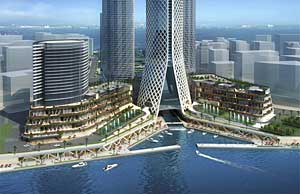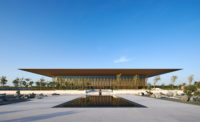With its climate-defying indoor ski slopes and outdoor golf courses, the United Arab Emirates might seem the least likely place to tout environmentally sensitive design. Last year, the World Wildlife Fund ranked the Emirates first among the world’s 71 most populous nations in consumption: roughly 30 acres of land and water are needed to sustain the needs of each citizen per year, compared to the average of just 4.5 acres in other nations. The U.A.E. also gets poor marks for its high levels of carbon emissions and its reliance on fossil fuels, half which are used to power, light, and air-condition buildings, according to Hilson Moran, a global engineering consulting firm that recently studied the Emirates.



Gensler’s Tameer Towers, a mixed-use complex in Abu Dhabi, aims to be among the new crop of green buildings constructed in the United Arab Emirates.
There are signs of change. His Highness Sheikh Mohammed bin Rashid Al Maktoum, who is both vice president of the U.A.E. and the ruler of Dubai, announced this fall that new buildings in his city must meet strict green standards starting in January. The move comes as the 16-month-old Emirates Green Building Council (EGBC) works to formulate a list of standards to rate projects’ sustainability. The World Green Building Council—a 10-nation group that includes Japan, Spain, and the United States—has approved the U.A.E.’s version, but the EGBC is still awaiting permission from the U.S. Green Building Council (USGBC) to license the Leadership in Energy and Environmental Design (LEED) standards. This would convey to the U.A.E. a desirable imprimatur of eco-mindedness, but both sides are still hammering out the details about how U.S. requirements can translate to a radically different climate.
“There’s one side that says you should never reward some of the kinds of development they’re doing, with all the resources they are using up,” says Thomas Hicks, a vice president of the USGBC. “On the other hand, they’re doing some great work.”
In fact, there are 70 planned U.A.E. buildings now aiming for green status, according to Hilson Moran, which has a seat on the EGBC. One is Abu Dhabi’s Tameer Towers, a $100 million mixed-use development designed by Gensler, the international architecture firm, which has a Dubai office. With 9 million square feet across six slender diamond-shaped towers, the complex will feature 1,900 apartments, a hotel, shops, and offices when completed in 2011.
Among Tameer’s sustainable features, residences will be tucked under landscaped terraces, keeping them cool naturally, and the buildings will sit astride a canal patterned after the San Antonio Riverwalk and meant to encourage people to walk rather use cars. The latticed skin of Tameer’s towers, some 72 stories tall, will be made of locally produced pre-cast concrete panels, saving the import of construction materials. “The U.A.E. is picking up on messages from around the world, and one of those is sustainability, and they have the ability to implement it,” says Chris Johnson, a Gensler managing principal.
But to do so, the country should pay heed to its own vernacular forms—large tents, for example, cooled by breezes and not air conditioning—and not rush to re-create a Manhattan-style skyline, contends Robert Fox, a partner in Cook + Fox. In 1995, he helped design Four Times Square, in New York City, which is often cited as one of the earliest green skyscrapers in the U.S. Fox worries that a U.A.E.-specific LEED ratings system could allow developers to score extra points for, say, photovoltaic panels while neglecting fundamental design issues. “What are the lessons they could learn from their forefathers?” he wonders. “I don’t think that any of the forefathers thought that skiing in the middle of the desert would have been a good idea.”



Post a comment to this article
Report Abusive Comment